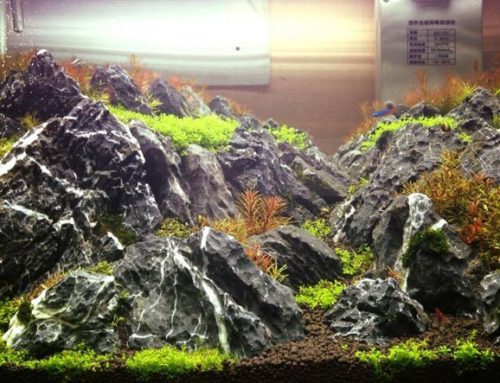Project Description
Entry #5 Mr. Nikorn Sae Tang

Nikorn Sae Tang is in the theater business but three years ago, he began developing a love for aquatic plants. Water, plants, gravels, rocks, soil, and sand all exist within a specific space and time. The ability to admire the beauty of life in a planted aquarium brings peace, pleasure, and happiness.
The Thai version can be found here.
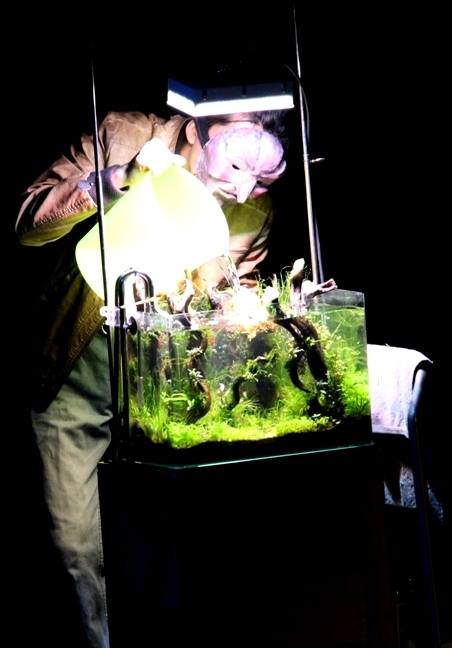
I’ve even used my aquascape as part of a play.

Filling the tank to clean and check for leakage.

Washing the rocks that have been selected.

Drain the water and dry the tank before adding the two substrate additives by CAL AQUA LABS

I added 1 spoonful each of these two substrate additives (spoon was included in the bottle)

Putting the base substrate into mesh bags not only prevents it from mixing with the soil, but it also helps create a slope as well.

Adding the soil. Thanks to our sponsors.

Placing the rocks while adding soil with a small cup.

Option A

Adding more rocks

View from a different angle

Try removing some rocks, leaving only a few.

Trying to create a point of interest. This should be Option B.

Let’s start again. I want fewer rocks so there is more space for plants.

This angle looks pretty good

Starting again once more. Seeing what happens if I show off a field of rocks.

View from above

This is layout C. I’m going to take a break here. I need to produce a play in Tokyo for 10 days. When I come back I will see if this is what I really like or redo the hardscape. Thank you for following my work.

28 Dec. I’m back from my stage play. I want this tank to have a story so I decided to put them in pairs as if they are characters within a play. All the stones are arranged into pairs except for two that are in separate corners. I want it to feel like they are walking towards one another. This is a fun layout and I like the meaning and story. However I think there is too little space for plants.

I tried changing the positions of all the rocks in front. I also changed the main pair in the middle, making one more delicate to be the leading female character.

I tried adjusting the other rocks that plays supporting roles, and removed one of the front rocks. I began to feel like the main pair looks a bit bland so I made some adjustments as well.

Right now I like this layout. There is more space for plants, and the two main rocks look good with nice depth. I will contemplate this layout for several days. Right now I have prepared the plants and know where to use them. But I think I will wait a while. I don’t want to rush things as I won’t be able to correct them later. Right now when I look at the layout I feel like the two main stones are staring each other in the eyes, while the other pairs are already embracing one another. The two that fell down was because they could not be together. ha ha ha. But I must not forget that this year’s theme is Rotala Revolution. I name this tank “The look of love”. I take this opportunity to wish everyone Happy New Year. See you again after the party. Next time I will begin planting.

Latest update: January 3. I adjusted the layout as shown. I sprayed the tank and wet everything with water and left it so that the soil becomes cohesive and doesn’t spill down when planting. In the meantime, I prepared the plants. When I began planting, I removed the inflow-outflow first. Here I just installed it for the photo. But when I started to plant they really got in the way. Ha ha ha.

Preparing the plants that I will be using. These plants are tissue-cultured. I took them out and wash all the agar away, then separate them into bunches for quick planting. This set includes mini hairgrass, twisted hairgrass, R. rotundifolia “mini butterfly”, Staurogyne repens, and Cryptocoryne nevellii.

Stem plants sold in pots. Wash them thoroughly in case they have some snail eggs, then divide them into bunches for planting. The set includes red Bacopa (from Green Space store), Rotala sp. “Vietnam”, and Rotala wallichii.

Plant the hairgrass first then fill the tank. I made my way towards the back according to the height.

Rotala sp. vietnam between the rocks.

Ludwigia goes on the right side.

R. wallichiii goes on the back right. R. sp. “mini butterfly” is at the center mixed with the hairgrass. Let’s see which will first carpet the area. Quite entertaining to see.

Fill the tank slowly but I’m not afraid of clouding by the soil because Black Earth has no problem with dust and debris. However if you turn on the water too strongly the soil might get blown away or the plants might easily become loose.

I used a plastic container to prevent the water from coming out too strongly.

Remove the fallen leaves so they do not clog the filter or rot and become detritus.

Install the filtration system and lights. Noticed that I did not fill the tank all the way up to allow some tinkering during the first few days. Plants still have not taken root and might float up due to the current. Replanting them requires us to stick our hands in so the water will not overflow.

A-series lights by Chihiros allows adjustment of the brightness in 7 levels. Pressing the button ones turns it on, and the following 6 levels adjusts the brightness. The light is very bright at level 7 which is suitable for red plants. In the first week I will use level 4 for 6 hours a day because the plants have not adjusted. If I turned it up too bright algae might show up too quickly.

Set the CO2 at 4 bubbles per second and connect it to a reactor.

I added some bacteria from AZOO to help the establish the biological filtration. The label says 20 ml for 100L of water. I roughly calculated taken into account the volume of the filter to be no more than 50 liters so I added 10 ml.

After filling the tank and installing the equipment, I started the clean up process.

Took this picture as a souvenir. I plan to leave it for two days before completely draining the tank to make the soil more compact and eliminate excess nutrients (this is my personal belief based on no theories whatsoever..ha ha ha).

One important step for this tank is to be able to predict how the plants will grow in and change. I am pretty sure I will need to change things a bit after the first water change. Please stay tuned. Right now I am begining to feel like the main rocks are too slanted towards each other.

Saturday January 7th. I drained the water out completely once more and observed some melted leaves came out with the water. The plants are adjusting by dropping the old, damaged leaves. Try to use a hose to remove these leaves as many as possible as a way to eliminate waste inside the tank.

I added some more plants. The shop owner called this “Eus”. I later found the English name: POGOSTEMON STELLATUS (EUSTERALIS)

Tissue-cultured Rotala mini Type II. I am rooting for them because they are so tiny and so hard to plant. I wonder what it will look like once it is established.

These Alternanthera reineckii are so hard to find. Most of the ones you find are very large but this mini type is out of stock. I got them from V Aquality Fish Farm . Thank you very much.

I moved the Ludwigia to the back.

Re-fill the tank and added 1 capful of AZOO bacteria. I used an outflow that helps reduce the water current.

Next is to wait till the plants grow in. We have to carefully nurture them until they are strong and established. Then we can trim. If we don’t trim the stem plants, they will look messy and will shade one another. This will make the ones at the bottom suffer. See you again in the next post. If you have any questions or comments, please feel free to ask. If I don’t know the answer I will ask someone else for you. Enjoy your tank and your work.

I added in a third A-Series light to get uniform lighting over the tank. I set the intensity level of the front and back lights to 5 and the middle at 3. Lighting time is six hours a day.
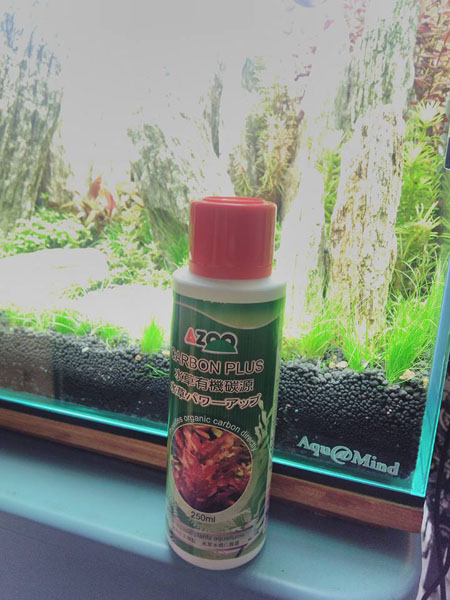
I added AZOO Carbon Plus that helps with nutrient absorption and photosynthesis. I only put 10-15 drops every 2nd day. It also helps control algae.

January 10. Noticed that the tips of Rotala mini butterfly and Rotala rose are beginning to perk up.
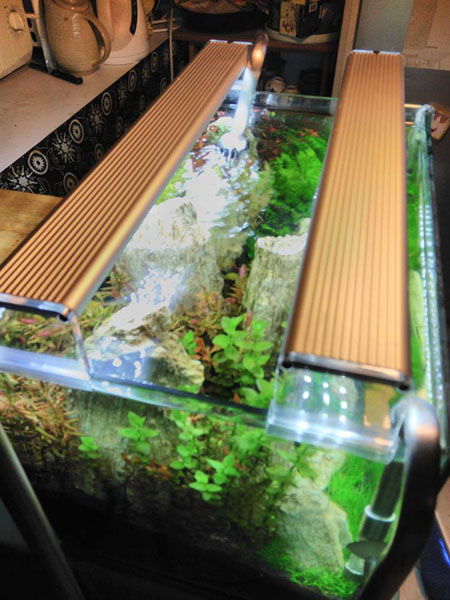
Slight change of plan. To show that all of us are subjected to the same equipment constraints, I removed one of the lamps. Just to make everything even.

I resorted to moving the lights directly above plants that require more lights. In the future there would probably some adjustment on the lighting position according to the plant conditions as well as the lighting intensity (right now both are at level 5).

Released some shrimps to control algae.

Released some shrimps to control algae.

Released some shrimps to control algae.

The Ludwigia sp. is growing so fast it is almost creeping outside the tank.

Hairgrass is beginning to send out runners. I normally trim them to stimulate new growth and accelerate their spreading.

Here are the scissors that I use. The right one has a spring to it. The good point is that it is small and can get into tight spaces. The middle one needs more room to operate but can cut thicker stems. The long one on the left is for when you are too lazy to stick your hands into the water or to get into tight bushes and spaces.

When trimming hairgrass, trim them short. This will accelerate them to send out new growth and runners. Use small, narrow scissors to get into tight spaces between rocks and the glass.

Before and after trimming. You can see that I didn’t cut them the same length, but rather just cut them short. They might appear uneven but that is just my personal taste that I don’t like things to be too orderly.
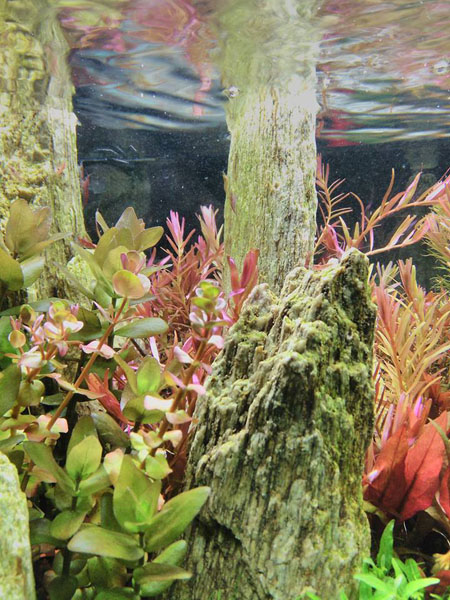
For those who is wondering how red plants do under the A-series lights. I did not use any filters for this picture.

I changed the main pair of rocks slightly because as the plants grow, I felt that the main rocks are too tall and blocked too much of the background view. So I choose a new leading rock, which actually is just switching the left rock for the one on the right, and putting the round rocks together. This is one good thing about not gluing the rocks down, that is you can change things all the time.

The Rotala that I cut and replanted last week have now reached the surface. I’ll trim them on Monday to create a bushy appearance.

The Rotala tips that I cut and replanted last week have now grown to the surface. I will trim them again this Monday and make them more bushy.

January 30. I trimmed the Rotala, but this time, I didn’t replant the tips as the area is already bushy enough. Check out the before and after photos and you can easily distinguish them apart. Today I also did a water change and added some bacteria and a cap of Red Advance from Azoo. I also added about 5 ml of iron. Tomorrow morning when the lights turn out, I will add the liquid carbon from Azoo according to the recommended dose. Adding it now will not be good as the plants have just been trimmed and the open wounds can rot. Actually we should add even add it twice a day. However, when the lights are off, the plants won’t use it anyway.

This corner is waiting to be trimmed on Friday.

I just trimmed the right side which contains Eusteralis stellata and R. wallichii. I left the Rotala sp. “Pearl” for the next trim.
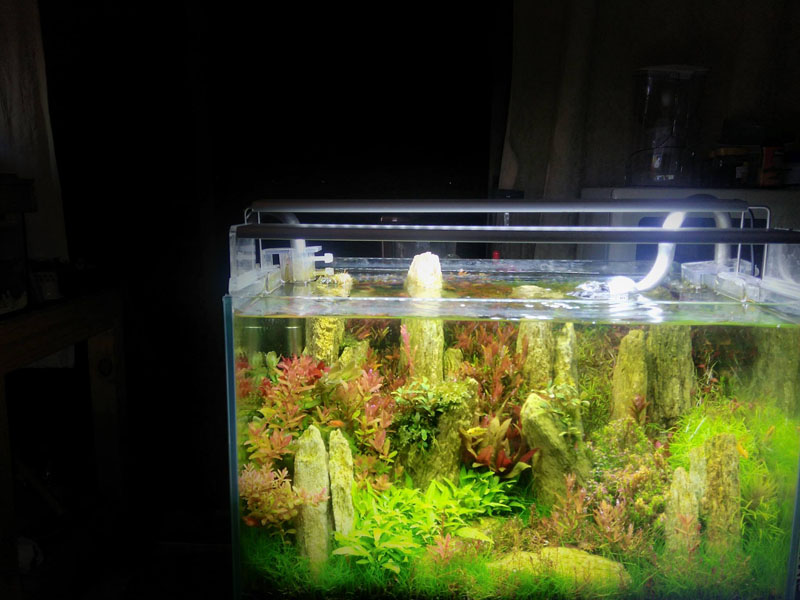
3 days after trimming. I added some algaecide and will do a water change on Monday.

Mollies help eat algae. They are also no less cuter than other types of fish.




